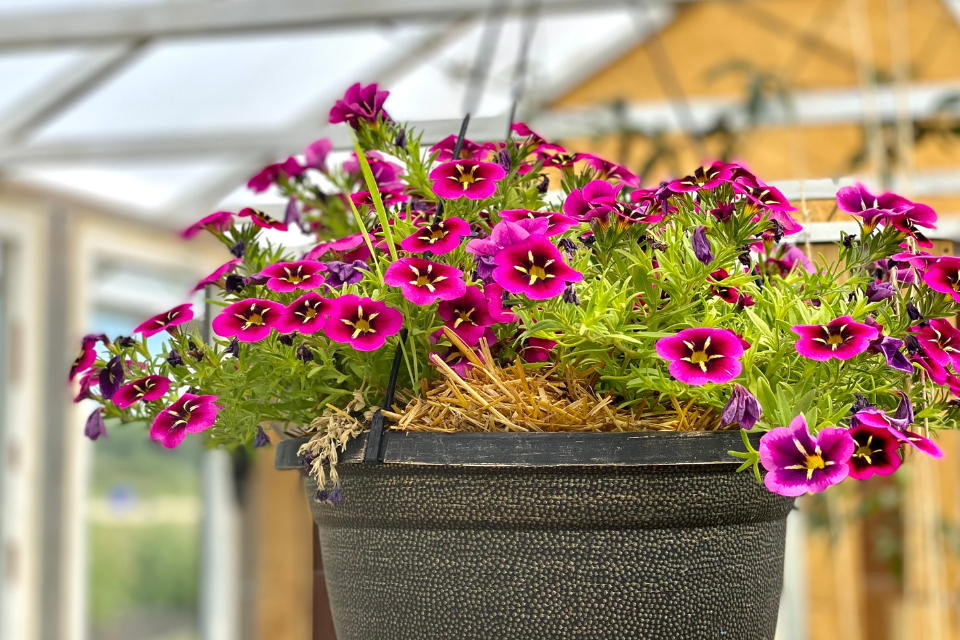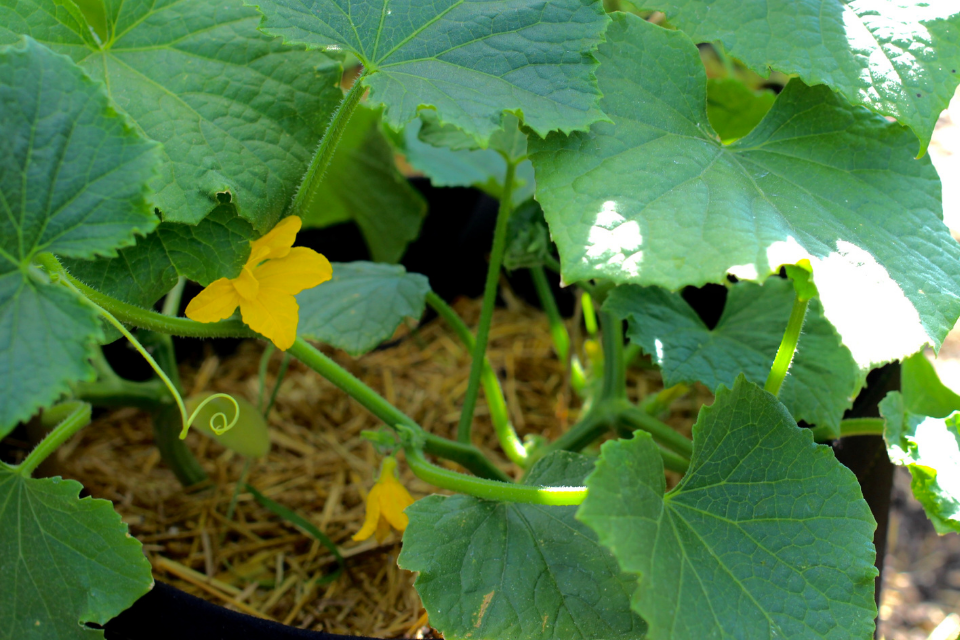How To Use Garden Straw As Mulch For Vegetables

You’ve likely seen straw used as mulch for strawberries, or maybe even for garlic. But did you know you can and should use it throughout your entire garden? It’s true! The benefits of using straw mulch are plentiful. Plus, it will make your life as a gardener easier and more enjoyable.
In this post we cover:
- Why Mulch Your Garden
- The Benefits of Straw Mulching
- Where to Get Straw Mulch
- How-To Apply Straw to Your Veggie Beds
- Best Plants to Mulch with Straw
Why Mulch Your Garden
A definition feels like a good place to start! So what exactly is mulch? Mulch is considered any material that is spread over the surface of the soil to act as a protective cover.
Mulch can either be an organic material, like garden straw, or a man-made product, like landscape fabric. Regardless of what you use, the purpose of mulch remains the same, which is to cover and protect the soil around the base of your plant.
So why mulch your garden? Well, there’s a laundry list of positive benefits! Here’s a few of the reasons why we use mulch pretty much everywhere — in our gardens, greenhouse, raised beds and containers.
- Mulch retains moisture in the soil by reducing evaporation that typically happens when your soil is exposed to direct sunlight. Research shows mulch can actually reduce watering needs by 50% (great for those long weekends spent at the lake!). We find this especially helpful for the plants in our greenhouse that tend to dry out quickly in their warm environment. Not only will mulch free up the time you would otherwise have to spend watering, but it will also help you conserve and lower your overall water usage. A win-win!
- Mulch suppresses weeds by blocking out the sunlight weeds require to germinate and grow. Now, organic mulch isn’t a 100% effective way to entirely stop weed growth, however it definitely does help. We find any weeds that do push through the mulch have shallow roots and are easy to pull out.
- Mulch keeps the soil cooler in the summer and warmer in the winter supporting the overall health and sustained growth of your plants. In the heat of summer, a thick layer of mulch can really help slow plants from bolting. It also eliminates some of the stress plants experience in extreme heat by keeping the roots cooler. In the winter, a good layer of mulch does the opposite, protecting your plants from frost and extreme cold. We apply mulch in the Fall to act as a protective layer of insulation for our more tender perennials that aren’t necessarily “Zone 3 hardy,” such as lavender, oregano, mint and rosemary.
- Mulch can help reduce the risk of soil-borne diseases. Fungi, bacteria, pathogens, viruses and nematodes are causes for the more common types of soil diseases. Mulch acts as a buffer between your plant and the soil to stop disease from spreading to the plants’ stem and foliage.
There’s a handful of different types of organic material you can use as mulch, such as shredded leaves or grass clippings, wood chips and newspaper. The choice is up to you, but in my experience, straw mulch is the superior choice! Keep reading to see why.
The Benefits of Straw Mulching
When it comes to straw mulch specifically, all of the above listed benefits also apply — moisture retention, weed suppression, etc… However, the biggest benefit for us organic gardeners is that straw breaks down over time, feeding and building your soil’s health.
This is a key reason why we love straw mulch! It plays a vital role in ensuring our soil is healthy and alive.
Microorganisms gradually eat and break down the straw, using it as an energy source. As it breaks down, the straw will make your soil more porous, creating space between particles of soil.
Porous soil retains more moisture and oxygen making it easier for your plants’ roots to absorb.
As our mulch gradually decomposes throughout the growing season, we typically reapply our straw mid-July. At this point, we’ll notice nearly half of our mulch has already broken down into the soil.
* Note: I would caution to not mix large quantities of straw into your garden. Some believe adding an excess of straw can actually throw off the carbon/nitrogen balance of your soil. In our experience, we have only ever used straw as mulch and not as an organic matter to amend our soil. We let our straw mulch break down naturally over time and have never had any issues with soil health.
A few other benefits specific to straw mulch, include:
- It’s lightweight, making it easy to apply to your garden beds or small spaces like hanging baskets. This also makes it a great option for mulching seedlings or sprouting seeds.
- It makes your garden beds look more attractive. Aren’t we all aspiring to have a gorgeous garden? Straw creates a clean look around your plants. I personally love the contrast straw mulch adds to the bright, green foliage of our plants.
- It goes a long way! We use two (2) 20lb bags of straw to mulch our entire 500sq ft. garden as well as all the containers in our greenhouse.
A common question gardeners often ask when I share my love for straw mulch is “But doesn’t it blow away?” The answer is no!
As long as you water your straw after laying it around your plants, it will bind together and stay nicely in place. Our garden is located in a space with little to no wind protection and we don’t have any issues with this.
Where to Get Straw Mulch
First things first, be very cautious about where you are sourcing your straw mulch from.
Conventional straw bales may be easy to come by and cheaper in price, however they are likely treated with herbicides and pesticides, which can be damaging to your veggie garden.
Look for straw mulch that checks all the boxes listed below:
- Certified organic
- Wheat straw
- Lightly processed (to remove dust/seeds)
- Cut to a consistent length
The other important thing to note is that there’s a difference between straw and hay. Hay bales contain seeds that you don’t want to introduce into your garden, such as alfalfa and clover. Whereas wheat straw is made from the stalks of cereal grain crops, making it lighter and slower to break down.
So where can you find straw to mulch your garden?
We are BIG FANS HealthiStraw, a local Manitoba brand with retail partners across North America.
HealthiStraw carries a garden-specific straw mulch that is processed to the ideal length and form to encourage healthy plant growth. This is our go-to product each season! It comes conviently packaged in 20lb (9kg) bags.
Use the retail partner finder on their website to find the closest location to you that carries their products.
https://www.instagram.com/p/CO_CIFBnZY1/
How-To Apply Straw to Your Veggie Beds
You can apply straw to your garden beds at any of the following stages:
1. After transplanting seedlings — Mulch in between plants, applying 3-5 inches of straw. Be careful not to have the straw touching your seedings’ stems as it can spread fungus. Reapply another 2-3 inches once plants are established.
2. Once plants are established — Apply a thick layer of 5-6 inches of straw mulch around the base of your plants. If filling a raised bed or container, mulch the entire soil surface area.
3. Throughout the gardening season — It’s never too late to mulch! You can apply straw mulch at any point. We also suggest reapplying a few inches of straw at the mid-way point of your growing season as some of it will have broken down by then.
Here’s how to apply straw mulch?
Apply your straw by hand, placing large handfuls around the base of your plants. Gently pack it down and smooth over soil. Be sure to water directly after applying to ensure straw does not blow away. Once wet, straw becomes heavy and will stick to your soil.
To ensure your mulch is most effective at retaining water, apply a thicker layer on plants that receive more direct sunlight throughout the day.
We apply almost 8 inches of straw mulch to our greenhouse tomatoes and cucumbers. It sounds like a lot, but this amount of mulch allows us to go up to 5 days between waterings even during the hottest days of summer. It’s pretty amazing and totally worth it!
Best Plants to Mulch with Straw
We use straw to mulch pretty much all of our plants! It can’t harm your plants nor can it be applied “wrong.”
There are some instances where you might want to avoid mulching, such as after direct sowing before seeds have germinated, however over all it’s safe to say you can mulch nearly everything!
Here’s a few plants that especially benefit from straw mulch:
- Garlic – apply in the Fall after planting, remove early Spring.
- Perennial Herbs & Veggies – cut back plants in the Fall and apply straw overtop to act as a protective cover.
- Perennial Flowers – apply in the Spring after beds have been cleaned up of debris and plants have been well-watered.
- Annuals in Containers – apply a thick layer over entire soil surface.
- Fruiting Plants – plants like tomatoes, melons, strawberries and cucumbers will especially benefit as the straw will protect the fruit from sitting directly on the soil.
You can use straw mulch in other ways too, such as creating pathways between plants. Or, throw straw in your compost bin to add more carbon. It will break down quickly.
Happy mulching!






